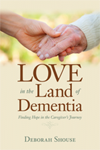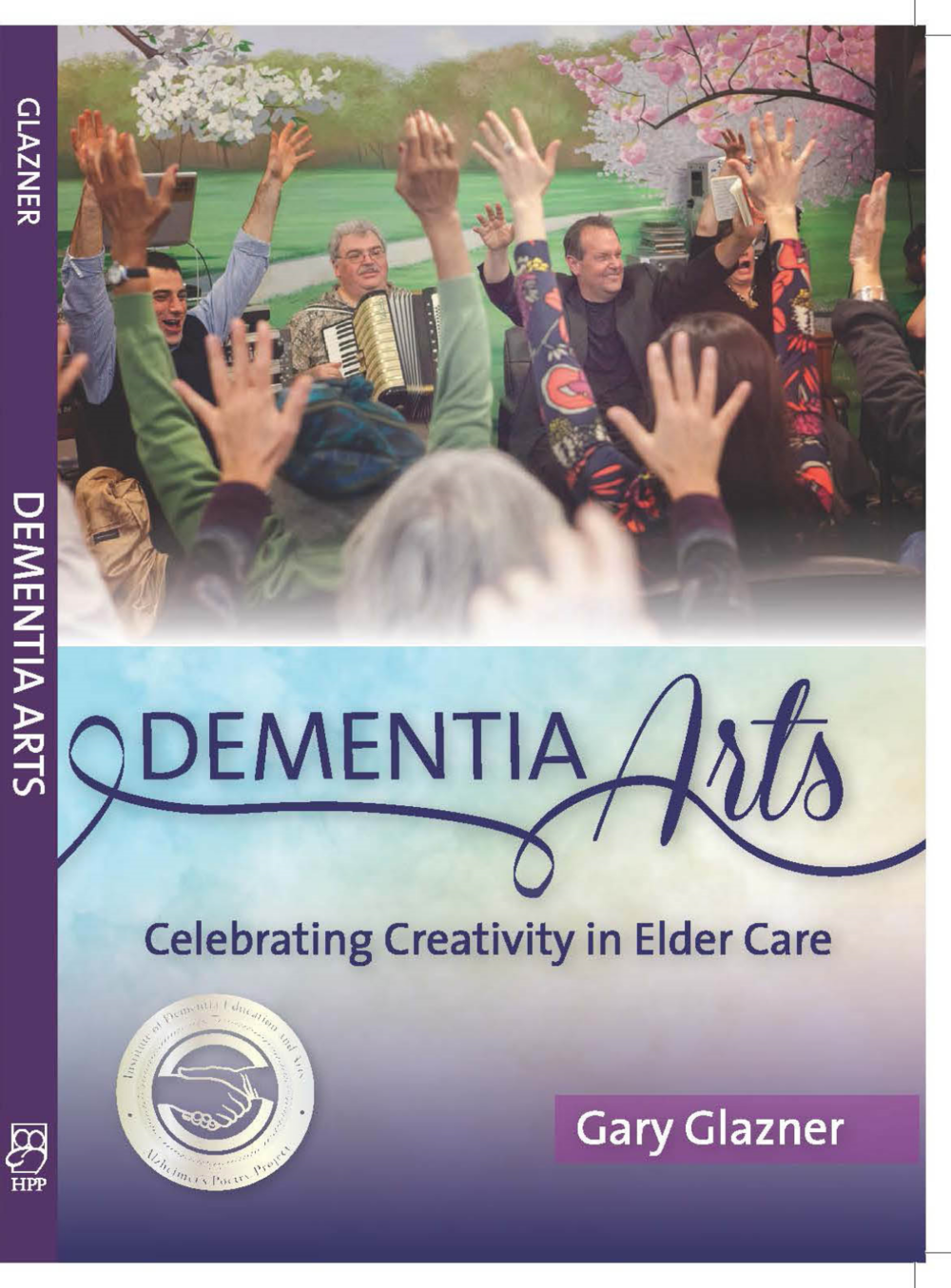Posts Tagged ‘communication’
Redefining Dementia and Focusing on Wellbeing
Several months ago, I was delighted to write an article highlighting some of the American leaders in dementia care. I will be occasionally spotlighting luminaries from that article who are redefining dementia and focusing on wellbeing.
A version of this piece appeared in Signpost Journal: Journal of Dementia and Mental Health of Older People. This excellent journal from Wales, UK, offers a variety of informational and inspirational articles. I am honored to be a contributor.
Redefining Dementia and Focusing on Wellbeing
Late every afternoon, Roger paces the corridors, pausing at the locked door, fiddling with the keypad, sometimes even setting off the alarm before he resumes his pacing. Instead of labeling Roger’s behavior as “sun downing,” Allen Power, MD, teaches practitioners to ask themselves: Which vital element of health and happiness is missing from Roger’s life: identify, connectedness, security, autonomy, meaning, growth, and joy. By doing this, Dr. Power is redefining dementia and focusing on wellbeing.
Dr. Power is a geriatrician and educator on transformational models of care, with a focus on people living with changing cognitive abilities. He is also the author of two groundbreaking books, Dementia Beyond Drugs and Dementia Beyond Disease: Enhancing Well-Being.
He defines dementia as, “A shift in the way people experience the world around them.”
“I believe that most of people’s on-going distress is due to the erosion of one or more aspects of well-being, from the care environment, and/or the person’s cognitive changes. Imagine these domains of wellbeing as seven glasses being emptied. Start filling the glasses and notice the results.”
As Dr. Power trains and consults with memory care communities around the world, he sees meaningful results from this compassionate approach. Suddenly, Mary is not constantly calling out night and day. Bill is not hitting the aides when they take him to the shower. Roger is not setting off the alarm or trying to open the exit door.
“There’s no sure answer,” Dr. Power says. “You need to understand the individual and experiment until you reach the root of the problem. People may be looking for connectedness. They may feel anxious and insecure. They may be bored.”
If someone is repeatedly trying to leave the building, Dr. Power might ask: Are they feeling insecure? Are they feeling lonely and trying to reach someone they love? Are they yearning to connect with an important part of their identity, such as a beloved garden, horse, dog, or pick up truck?
Working toward an Inclusive Future
Dr. Power uses a strength-based approach to work on enhancing wellbeing. He encourages developing “brain ramps,” cognitive supports that help people move through the day in meaningful ways.
“With this positive approach, I can now look at a challenging scenario and offer insights,” Dr. Power says.
Beyond the care of the individual, Dr. Power believes in examining ingrained rituals and routines of institutionalized care, including all meals at a certain hour, with an aim of moving to a more individualized and meaningful mode of care.
“We can make mundane activities such as bathing or getting ready for bed more meaningful and relational than we normally do in long-term care,” he suggests.
“We need to support people instead of dehumanizing them,” he says. “We need to be inclusive and try harder to understand them.”
Dr. Power believes integration into society is a basic civil right.
“Imagine if people who lived with cancer, arthritis, or diabetes could only live with others who shared their medical condition. There’s a problem with seeing the disease instead of the people,” he says.
Dr. Power is contributing to a future where all communities are dementia inclusive and where dementia is just viewed as another way that people see the world.
For more about Allen Power, MD, internationally known geriatrician, educator, and author , please visit:
Website: http://www.alpower.net
Dr. Power is participating in Dementia Action Alliance’s Reimagine Life with Dementia Conference, June 25-27.
http://daanow.org/wp-content/uploads/2016/10/DAA-Conference_042817.pdf
Deborah Shouse is the author of Connecting in the Land of Dementia: Creative Activities to Explore Together and Love in the Land of Dementia: Finding Hope in the Caregiver’s Journey.
One-minute Tips to Boost Your Happiness
For three weeks, a small pile of books huddled on the floor of my bedroom, next to the bureau. Every time I saw those books, I thought, “I should put them away.” But I walked past them, too busy. Until I read Amy Newmark’s new book, Simply Happy. One of her tips challenged me. “What can you do in one minute?” I took the “One-Minute Tips to Boost Your Happiness” challenge. I swooped into the bedroom, scooped up the tomes, and put them in the bookcase. Then I looked at the blank carpet and smiled. That quick action filled me with joy.
Amy Newmark left her high-powered career as a Wall Street analyst to take over the Chicken Soup series. After years of immersing herself in true stories of miracles, lessons learned, and hopes fulfilled, she wrote her own book, Simply Happy. I was so inspired by Amy’s insights, I asked her to offer a few ideas for busy care partners. Here are some of her “One-Minute Tips to Boost Your Happiness.”
Amy’s Insights for Care Partners
Counting Blessings Adds Up to Happiness
“The gateway to happiness is counting your blessings,” Amy says. “If you’re not grateful for what is in your life, how can you be happy?”
Scientific studies have proven that people who are actively grateful are happier, healthier, and more productive. Plus, they get along better with family members, colleagues, and others.
“You can easily learn gratitude,” Amy says.
To start, each day jot down three things for which you’re grateful. Strive for three different ideas each day. At the end of the month, you’ll have documented nearly a hundred blessings.
“Writing and speaking your gratefulness changes your perception,” Amy says. “You start looking for good things during the day. You can share your blessings with your partner and encourage him to consider his own.”
Some people drop the blessings into a box, and then read them at the end of the day or the end of the month.
Smiling Serves You
Smile even when you don’t feel like it. Often, when you smile, people smile back. This boosts everyone’s spirits and energy. If they don’t give you a grin, it doesn’t hurt you.
“Your smile will change the way people react to you,” Amy says.
Zipping from Zero to 60 Brings Joy
Set a timer for 60 seconds and zip through a task you’ve been putting off. File the insurance policy that sprawls across the dining room table. Unload the dishwasher. Take your vitamins.
“Doing even one of those tasks every day will lighten your spirits,” Amy says.
Dropping Perfection and Embracing Your Own Abilities
Abandon your pursuit of perfection and strive for your own version of excellence.
“When you try to be perfect, you can’t get a lot done,” Amy says. “For most of us, it’s better to do five things at 90 percent than one thing at 100 percent.”
I love Amy’s final piece of wisdom:
“Treat yourself nicely,” she says. “Use the fragrant soap you save for guests. Indulge in a rich bit of good chocolate or a fresh crisp apple. Put the good sheets you save for company on your own bed.
Give yourself a tiny pleasure every day.”
For more happiness boosts, read Simply Happy.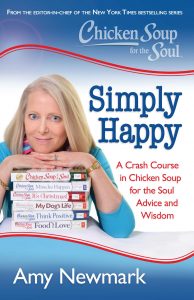
Visit Amy’s website at www.amynewmark.com or www.chickensoup.com
Extra tip from Deborah: If you like to write, consider submitting one of your own life stories to a Chicken Soup book. I’ve shared my stories in dozens of their books and it’s such a meaningful experience. Go to www.chickensoup.com, scroll down to the bottom, and click on “Submit Your Story” to learn how.
Deborah Shouse is the author of Connecting in the Land of Dementia: Creative Activities to Explore Together and Love in the Land of Dementia: Finding Hope in the Caregiver’s Journey.
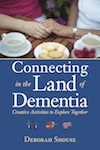
An Insider’s Tips for Finding Joy in the Journey
“Alzheimer’s can be a grind,” a caregiver recently told me.
That’s one reason I am constantly seeking those who see the creativity and potential in the journey. I look for inspiration and I found plenty in “Finding Joy in Alzheimer’s: New Hope for Caregivers,” a book by Marie Marley, PhD, and Daniel C. Potts, MD, FAAN. Both have a powerful personal story that they weave into the book, along with practical tips for care partners.
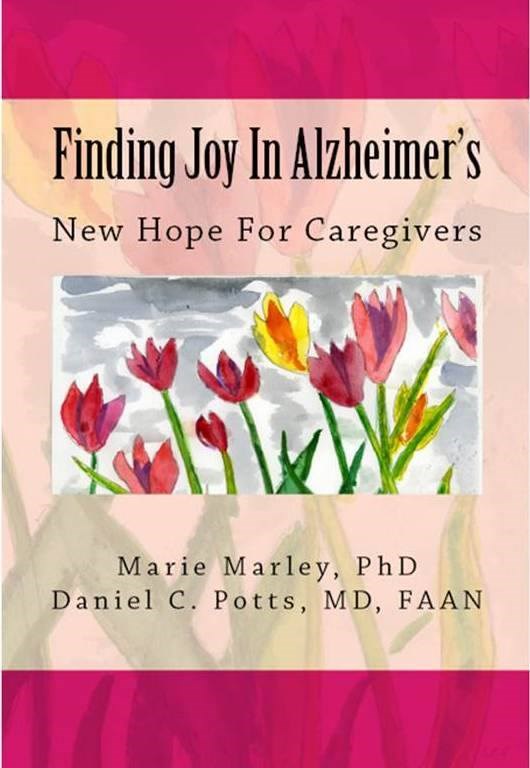 Three Ways to Encourage Your Own Love and Acceptance
Three Ways to Encourage Your Own Love and Acceptance
Here are a few excerpts from Daniel:
- Each interaction we have with another person presents an opportunity to share the hope that is within us.
- As care partners, we must identify and embrace the love present within each individual and we must enable the expression of that love, for personhood to be preserved and dignity promoted. We must also be fully cognizant of the love within ourselves.
- To come to terms with Alzheimer’s you must first let go of the expectation that you’ll find the previous person and instead embrace the new person– just as he is in the present. Since that person will continue changing as time goes by, one must constantly let go of the old person and accept the new one.
Three Ways to Improve Your Time Together
Marie offers these tips for staying connected:
- Use welcoming body language. Don’t sit with your arms crossed; sit with your palms turned upward. This posture says, “I’m receptive to you.”
- Speak slowly and in short, direct sentences, with only one idea to (in) each sentence.
- Laugh a lot. Arrive for your visit with a supply of simple jokes and funny stories.
For more information about Finding Joy in Alzheimer’s, visit ComeBackEarlyToday.com
Deborah Shouse is the author of Love in the Land of Dementia: Finding Hope in the Caregiver’s Journey.
Creating Personal Stories from the Care Partner’s Journey
My mother’s Alzheimer’s drove me to write. My writing inspired me to speak.
Over the last years, I have received enormous pleasure from connecting with people all over the world, sharing the stories from Love in the Land of Dementia: Finding Hope in the Caregiver’s Journey.
It All Started with Grief
When I initially realized the depth of my mother’s memory loss, I was shattered with grief.
My initial reaction was:
Visit with mom.
Drive home, wiping tears from my cheeks.
Stumble into the house, walk into a chair or table, and misplace my car keys.
Sit at the dining room table and stare numbly into space.
One day, during the “staring numbly” phase, my partner Ron said, “Are you writing down your feelings?” It was a smart and sensible thing to say; the sort of suggestions I might make to him in a crisis. I was, after all, a writer.
“I don’t feel like writing,” I said.
But his words stayed with me. The next day, I slightly altered my behavior.
Visit with mom.
Drive home, wiping tears from my cheeks
Stumble into the house, walk into a chair or table, and misplace my car keys
Sit at the dining room table and write numbly for 20 minutes
Pouring my Emotions Out and Inviting Understanding In
I poured out my fears, anger and grief. After doing this for a week,
I began noticing how interesting my visits with Mom were; we were explorers on a wild inner trek.
I started documenting our time together, sometimes even taking notes during my visits. I wrote about the challenges, humor and blessings. I wrote about my conversations with my father, with friends and family and with the aides, the nurses, the social workers. As I wrote, I saw there was much hope, promise and energy in my new world.
As I shared my work with friends and family, I realized I was chronicling my mom’s last years and capturing part of our family history.
Putting Your Life on the Page
How do you take a challenging part of your life and bring it to the page? Here are a few simple tips:
Pour Out Your Feelings
Give yourself time to feel your emotions, whether it’s through writing, art, music or other. Writing down your feelings helps you understand the depth of what you’re going through. For me, writing helped change my fear into curiosity.
Notice the Details
Write down the particulars, noting simple concrete facts. You are a researcher collecting data.
Uncover the True Story
Look for the universal meaning in your specific experience. How have you changed? How will the reader change through reading your words?
Ask for Feedback
Read the story aloud to someone and see how it sounds. What’s working and what’s missing? Ask colleagues for a professional critique. Think over their advice and decide what is right for you.
I was lucky enough to read some of my stories to my mother and father and receive their blessing for my work. Anytime I featured people in a story, I shared it with them to make sure they were comfortable with the material. When they’re comfortable, it’s time to share with friends and a wider audience, if you wish.
Here are some writings from other people on this journey.
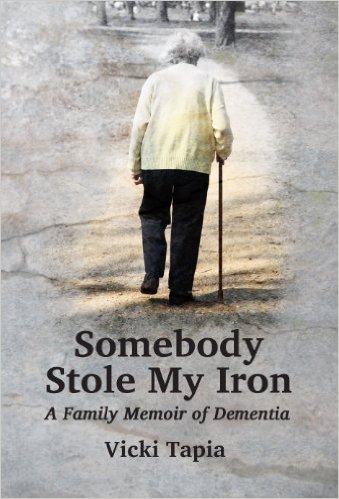 Vicki Tapia’s memoir, Somebody Stole My Iron, details the daily challenges, turbulent emotions, and the many painful decisions involved in caring for her parents. Laced with humor and pathos, reviewers describe the book as “brave,” “honest,” “raw,” “unvarnished,” as well as a “must-read for every Alzheimer’s/dementia patient’s family.” She wrote this story to offer hope to others whose lives have been intimately affected by this disease, to reassure them that they’re not alone.
Vicki Tapia’s memoir, Somebody Stole My Iron, details the daily challenges, turbulent emotions, and the many painful decisions involved in caring for her parents. Laced with humor and pathos, reviewers describe the book as “brave,” “honest,” “raw,” “unvarnished,” as well as a “must-read for every Alzheimer’s/dementia patient’s family.” She wrote this story to offer hope to others whose lives have been intimately affected by this disease, to reassure them that they’re not alone.
 Greg O’Brien’s story isn’t about losing someone else to Alzheimer’s, it is about losing himself. Acting on long-term memory and skill, coupled with well-developed journalistic grit, O’Brien decided to tackle the disease and his imminent decline by writing frankly about the journey. “On Pluto is a book about living with Alzheimer’s, not dying with it.” On Pluto: Inside the Mind of Alzheimer’s by Greg O’Brien
Greg O’Brien’s story isn’t about losing someone else to Alzheimer’s, it is about losing himself. Acting on long-term memory and skill, coupled with well-developed journalistic grit, O’Brien decided to tackle the disease and his imminent decline by writing frankly about the journey. “On Pluto is a book about living with Alzheimer’s, not dying with it.” On Pluto: Inside the Mind of Alzheimer’s by Greg O’Brien
Jean Lee’s memoir details her journey caring for both parents who were diagnosed on the same day. It is a WWII love story held together by faith and family. Alzheimer’s Daughter by Jean Lee 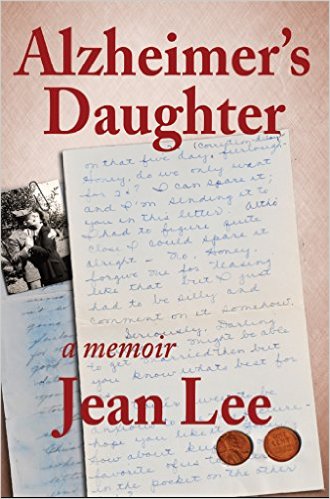
 Marianne Scuicco describes herself as a writer who happens to be a nurse. She writes this work of fiction based upon her care for the elderly. It’s a tenderly told love story about Jack and Sara, owners of a New England bed and breakfast. Sara develops Alzheimer’s and Jack becomes her caregiver. Blue Hydrangeas by Marianne Sciucco
Marianne Scuicco describes herself as a writer who happens to be a nurse. She writes this work of fiction based upon her care for the elderly. It’s a tenderly told love story about Jack and Sara, owners of a New England bed and breakfast. Sara develops Alzheimer’s and Jack becomes her caregiver. Blue Hydrangeas by Marianne Sciucco
Shannon Wiersbitzky writes this work of fiction through the eyes of a young girl, not surprising perhaps, as her author bio notes that her own grandfather had Alzheimer’s. In the story, when thirteen-year-old Delia Burns realizes that her elderly neighbor is beginning to forget, she involves the entire town in saving his memories. What Flowers Remember by Shannon Wiersbitzky
Deborah Shouse is the author of Love in the Land of Dementia: Finding Hope in the Caregiver’s Journey.
Four Easy Ways to Enrich People’s Lives
I wasn’t quite sure I wanted to lie on the floor on that large piece of white paper, but my first grade teacher did not give me a choice.
“Debbie,” she commanded, pointing sternly to the butcher block paper stretched on our school’s aging linoleum. Gingerly, I lowered myself to the ground, moving my arms away from my sides as instructed. Then two classmates traced around me with crayons. Our assignment that day was to draw in our features and our clothes. In essence, we were to clone ourselves using only primary colors.
Years later, at a self-exploration workshop, I again had to pour myself onto a sheet of paper and allow myself to be outlined. This time I was to draw or write in fears and beliefs along with accomplishments and dreams. This was definitely more fun than grade school and infinitely more challenging.
Just recently, I read about a “blank slate” exercise that I really liked. The booklet You Can Help Someone Live Fully With Dementia: A Guide for Family and Friends, suggests that we take an outlined profile and write down all the ways we might help a person living with dementia enrich his or her life.
I really resonated with this exercise. I also thought this was a beautiful idea to do for friends and family as well. How meaningful to think about ways to improve the lives of those close to us.
This brief book, which is accompanied by an inspiring DVD, offers simple tips to help us increase emotional connections during the dementia journey. Ideas include being enthusiastic and encouraging, thinking creatively when suggesting activities, focusing on the individual’s desires and strengths, and adopting a “no wrong way” spirit.
This succinct and compassionate guidebook reminds us of the importance of being guided by those who are living with dementia. The authors, Karen Love and Elia Fernia, are advocates who are making a difference in dementia care throughout the country.
Karen Love and Elia Femia, PhD are gerontologists and nationally known experts in dementia care. They are the co-founders of FIT Interactive, LLC. fitkits.org
For more information about living fully with dementia, please visit the Dementia Action Alliance www.thedaanow.org
Deborah Shouse is the author of Love in the Land of Dementia: Finding Hope in the Caregiver’s Journey.
Rock with Rhymes that Resonate
The audience was quiet, partially because some of the people were slumped over in their wheelchairs, eyes closed. Gary Glazner stood in front of the group, wondering if he could engage them. He had received a grant to offer a poetry workshop in a memory care unit and he had carefully selected several familiar poems. He’d introduced himself to everyone and he was ready to inspire people through reading poetry. But were they ready for him? He took a breath and began.
“I shot an arrow into the air,” Gary said to the seemingly comatose group.
“And it fell down I know not where,” said an elderly man without even raising his head.
That was the beginning spark for Gary Glazner’s Alzheimer’s Poetry Project, a process he created to help engage and connect with those living with dementia through reading aloud and discussing poetry.
“There are four steps to the process,” Gary explains. “First, a call and response, where I read a line of poetry and the group echoes it. Then we discuss the poem. Next, we add props to the experience and finally, we create our own poem.”
A few of the familiar poems Gary uses include:
The Tyger—William Blake
The Owl and the Pussy Cat—Edward Lear
Wynken, Blynken, and Nod—Eugene Field
How do I Love Thee?—Elizabeth Barrett Browning
Purple Cow—Gelette Burgess
Jabberwocky—Lewis Carroll
Daffodils—William Wordsworth
His website, www.alzpoetry.com, is brimming with verse and rich with recommendations.
Gary has shared poetry with people living with dementia all over the world. His usual session lasts around an hour. He often centers his poems on a theme, such as Summer, Birds, Trees, or Food, and enriches the gathering with objects that engage the senses. For example, to supplement summer-time poetry, he might include a bucket of sand and a conch shell. He brings a misting spray to simulate an ocean breeze and lets people smell suntan lotion. For refreshments, he suggests fresh strawberries, lemonade, popsicles, or homemade ice cream. This four-step poetry process also works at home with just two care partners
“Poetry goes beyond the autobiographical memory and offers care partners a way to communicate with someone who has memory loss,” Gary says.
Good news for the Kansas City area: Gary is doing a poetry workshop here in early October. For more information, contact Deb Campbell at kcseniortheatre@gmail.com
For more information on Gary and the Alzheimer’s Poetry Project, visit www.alzpoetry.com
Gary’s book is a great resource: Dementia Arts: Celebrating Creativity in Elder Care
Deborah Shouse is the author of Love in the Land of Dementia: Finding Hope in the Caregiver’s Journey.
Creating a Real Hit: Building Community Through Drumming
Life is about rhythm. We vibrate; our hearts are pumping blood; we are a rhythm machine; that’s what we are. – Mickey Hart
Some might have thought it a hassle to be hauling such a large load of percussion instruments, but Renee Kessler didn’t mind. She was thinking of the sudden smile she’d see when her mother-in-law began rhythmically shaking the maracas. Or the joy she’d see in Mr. Norman’s eyes as he beat the drums. She was glad to see the circle of residents in the memory care unit waiting for her and relished offering them choices of bells, clappers, triangles, drums, tambourines, and rain sticks.
“Through our drumming circles, we give people choices, we inspire them and we wake them up. Their eyes brighten when we play music,” Renee says.
Renee has a long history of waking people up through engaging them in creative arts. She worked as a teacher for an esteemed arts school in West Palm Beach, Florida, and now serves as a consultant, helping students prepare for arts programs. And she’s long been involved as a family care partner. When a drummer friend invited her to visit memory care units with him, she was eager to go; she’d been collecting instruments for years.
The experience was meaningful for all involved. Once they talked to each participant and distributed the instruments, the drummer set a beat and gradually everyone chimed in.
“We kept the flow of the energy and then we stopped and invited people to make random noise,” Renee says. “People were very expressive and eager to beat on drums, flap the clappers, and shake bells.”
Being part of rhythm and music energized and equalized everyone and built a sense of community, creativity, and connection.
Want to create connection through percussion instruments?
- Set the tone with a drumbeat or select a CD of familiar music with a definite beat.
- Offer a choice of noisemakers. If needed, you can beat a pen on a book or put some beans in a jar to make an impromptu shaker. Or you can hit two spoons together.
- Encourage your loved one to make as much noise as possible. Do the same. There’s liberation in making noise and there’s a sense of connection sharing the same rhythm.
Deborah Shouse is the author of Love in the Land of Dementia: Finding Hope in the Caregiver’s Journey.
Timeless Tunes that Transcend
“It’s really a very simple program, but the results are unbelievable. You watch the film Alive Inside and you think those are just the reactions they chose for the camera, but we really do see instant and unbelievable results from many of those we work with.” Linsey Norton
Barrick Wilson of Wichita, Kansas, uses music to connect with his beloved wife Kristi.
Kristi showed the first signs of dementia in 2004, when she was only 60 years old. She was diagnosed in 2008 and three years later, Barrick took early retirement so he could care for Kristi fulltime. There were plenty of tough times as Kristi’s disease progressed and music helped ease the issues. Often Barrick took Kristie for a ride and they’d listen to favorite songs as they tooled along.
“Bad, Bad Leroy Brown was one of her favorites,” Barrick says.
In the afternoons, they’d sit on the sofa and listen to Golden Oldies together, both singing along. Then Barrick learned about the Roth Project: Music Memories;” (which is similar to Music and Memory) and he signed Kristi up, working with the Central and Western Kansas office of the Alzheimer’s Association.
“I purchased a boxed set of Rogers and Hammerstein’s Broadway musicals, records her parents had listened to when Kristi was growing up,” Barrick says. “I included Jim Croce and Kristi’s grandmother’s favorite hymns.”
Barrick worked hard to develop a playlist that keyed in on Kristi’s emotional memories; volunteers from the Alzheimer’s Association helped load it onto an iPod. Then Barrick had the pleasure of sitting next to Kristi and reveling in her beautiful smile when she put on headphones and heard Some Enchanted Evening.
“The music is a calming influence,” Barrick says.
Kristi is one of a couple hundred people enrolled in the Roth Project through the Central and Western Kansas office of the Alzheimer’s Association.
“Our staff offers counseling services to care facilities and to families as to when and how to use the iPod, “ says Linsey Norton, the Association’s Program Director. “We also help care partners notice behavioral cues that allow them to reach for the iPod headphones instead of the anti-anxiety medication. We are working with chapters nationwide to help them develop iPod therapy programs for families in their communities.”
Music helped Kristi when she needed to transition to a memory care unit. The staff offered her headphones and her favorite songs several times a day. Kristi got up and danced when Leroy Brown came on.
Barrick is a pianist and has also incorporated the songs he used to play for Kristi when they were dating. During their courtship, he played the piano in her parents’ living room. Now he sits in the facility’s dining room, his wife by his side, and he plays I’m in the Mood for Love, If I Loved You and My Funny Valentine. These classic love songs transcend rational thought and create an engineering marvel, a bridge that connects Barrick and Kristi.
Barrick shares this advice for care partners:
- Find out as much about the disease as you can. Read, watch videos, become friends with the Alzheimer’s Association and listen to their advice.
- Take your time putting together a playlist that will trigger positive emotional memories for the person living with dementia.
- Be prepared to join the person with Alzheimer’s in her world. It’s like living in an improv theater; you don’t know what’s coming next.
- Take care of yourself. If you need help, ask for it.
Deborah Shouse is the author of Love in the Land of Dementia: Finding Hope in the Caregiver’s Journey.
Four Insights for Connecting with Cooking
“Mom, are you ready to help me make your famous meatloaf recipe?’ Stacy asked. Stacey was in town for the weekend, visiting her mom, Alice, and giving her sister a break from caregiving.
Stacy had wanted to take Alice out to eat, but her sister told her, “Mom can get pretty overwhelmed and confused when she’s around a lot of people. Why don’t you stay home and cook with her?”
Her sister was a nurse and seemed at ease with Alice’s diminished memory. But Stacy bit her lip when her sister suggested cooking.
“Think of a family recipe,” her sister advised. “Get all the ingredients organized beforehand and make sure the room is quiet and Mom has a comfortable chair. Once Mom gets started, she can do quite a bit. Just don’t rush her.”
It just so happened Stacy had been craving her mother’s famous meatloaf. That evening, she watched the news while she laid out the bowls, utensils, and ingredients on the table.
“A feast!” Alice exclaimed, as she shuffled into the kitchen. Stacy clicked off the television and said, “It will be a feast, Mom. It’s your meatloaf recipe. Will you help me make it?”
“You used to help me. In Provincetown,” Alice said.
Stacy’s eyes misted. Sometimes her mom didn’t seem to know who Stacy was and when that happened, Stacy could barely breathe.
“You stood on a chair,” her mom said.
“Wearing Grandma’s apron.” Stacy could see the apron, a frilly flowered chintz with a red ribbon sash.
“This is your grandmother’s recipe,” Alice said. “She lived in Boston, you know, with her older sister.” As she reminisced, Alice cracked and whipped the egg. Then she poured the mixture onto the beef and blended it in with her hands. She sprinkled the breadcrumbs into the meat, added a handful of her secret ingredient—raisins– and plenty of pepper, then mixed it all together.
Stacy gave her mother the pan and Alice expertly shaped the loaf. Then she noticed her messy hands and wiped them on her slacks. “Am I eating dinner with you? Where is the other one?”
“She is out with friends tonight. And yes, you are eating dinner with me.”
“What time will your father get here?”
Stacy looked carefully at her widowed mom and wondered what she should answer.
“It’s just you and me tonight, Mom.”
“Don’t forget the parsley,” Alice said.
While the meatloaf cooked, Stacy brought over some bread dough she’d thawed earlier. Alice had been a phenomenal baker and Stacy still remembered the scintillating taste of her mom’s cinnamon rolls. When Alice saw the dough, she began to knead it. As she kneaded, she talked about the types of bread she’d made when she was a girl. “Even sourdough,” Alice said. “Our cousin brought a starter from San Francisco and we were all a buzz.”
“Which cousin, Mom?”
“Oh that Gertrude. You remember her, always dolled up and always flirting with the men. But she could bake a good dinner roll.”
“What was your favorite thing to bake?”
Alice slid her hands over the rolling pin and rolled the dough thin. Then she tore it into little tadpole shapes, one of their favorite childhood treats.
“Remember, Stacy doesn’t like hers burned,” her mom cautioned.
Stacy smiled.
Even though her mother ate little and fell asleep at the dinner table, Stacy felt like the evening was a success.
“Cooking together can help family members connect in the kitchen,” says Kate Williams, LMSW,Care Counselor/Social Worker, Henry Ford Health System Collaborative, Alzheimer’s Association Greater Michigan Chapter. “The act of preparing food can draw on long term memory and trigger activities people have done in the past.”
Since the care partner needs to make meals anyway, working together offers a low-stress way to accomplish a task and a chance to relive family and food memories. People want to be useful and have a purpose; Kate believes creating food for and with someone meets that need.
For a successful cooking experience, Kate offers these tips:
· When designing cooking activities, consider the person and their current skills. Make sure the number of steps is appropriate to his or her level of memory loss.
· Give them as much independence as possible and be ready to help as needed.
· Create an environment with few distractions.
· Prepare the food and cooking utensils, so everything is at the ready. If possible, using the same type of equipment they used in the past.
Even for those who can’t really follow directions, the sensory experience of handling food can be connective and comforting. Cooking projects engage the senses, invite memories, offer a sense of completion and purpose, and are nurturing for both care partners.
Deborah Shouse is the author of Love in the Land of Dementia: Finding Hope in the Caregiver’s Journey.
Five Tips for a Terrific Collective Artistic Experience
Twenty years ago, Jytte Fogh Lokvig found herself in a quandary. She was doing a favor for a friend: visiting the friend’s mom weekly while the friend was out of the country for three months. The mom lived in a care facility and the first visit went wonderfully. But the second visit was shocking to Jytte.
“Her mom started screaming and cursing,” Jytte says. “I went to the nurses’ station to figure out what was wrong. The nurse told me she had Alzheimer’s.”
Jytte, who had experience in art and working with at-risk youth, knew nothing about dementia. But she started to learn. Using principles she’d employed with youth, she began offering additional activities at the facility.
“I didn’t view people with dementia as sick,” she says. “Everything I planned was directed at the well part of the person.”
She looked for activities that were collaborative rather than competitive, so everyone could bloom with a feeling of accomplishment.
“I started with a group collage,” she says. “That way, we were all working together.”
Through the process of creating collectively, people relaxed and became comfortable with the materials. This experience was so fulfilling and moving that Jytte began working with families, guiding them in doing projects together.
Jytte suggests collages because they are easy and there is no right or wrong with collage.
“Collect old magazines, buy a few glue sticks, and break down big boxes to use for cardboard,” she suggests. “Engagement and conversation are the important things; if it never gets beyond discussing a picture of daisies that reminds her of her growing up garden, that’s fine.”
Jytte believes the keys to engagement include giving people enough time, letting them work at their own pace, and offering them consistent opportunities for self-expression.
When possible, invite others to join you for the collage experience. Introduce the project by asking the person with dementia for help, saying, “Hey Mom, I really want to do this project. Want to help me?”
If Mom is reluctant, start the project and mention; “I sure could use your help if you don’t have anything else to do.”
Tear pictures out of colorful magazines.
Let Mom direct the artistic action.
Use the pictures to trigger conversation.
Enjoy the process and don’t worry about a finished product.
***
Jytte Fogh Lokvig, PhD, is the author of The Alzheimer’s Creativity Project and Alzheimer’s A to Z, Secrets to Successful Caregiving. She is also a founder of the Alzheimer’s Café.
Deborah Shouse is the author of Love in the Land of Dementia: Finding Hope in the Caregiver’s Journey.
